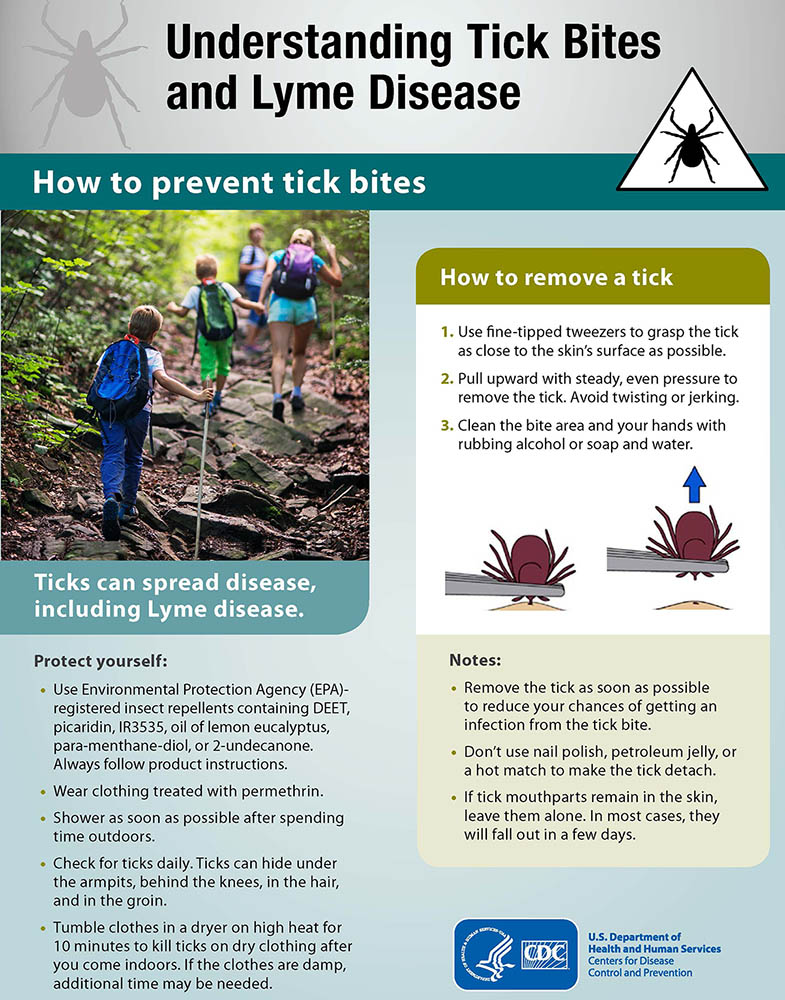How to Prevent Tick Bites & Lyme Disease
By Kristy Warren
Pennsylvania now consistently leads the country in number of Lyme disease cases, making prevention more important than ever. Scott Kroll, a certified registered nurse practitioner (CRNP) with the Laurel Health Centers, shares how to protect yourself and pets, what to do if you find an attached tick, Lyme disease warning signs to watch for, and when to call your family provider.
The black-legged tick (ixodes scapularis) is responsible for most cases of Lyme disease in Pennsylvania. While it is sometimes referred to as "the deer tick," it attaches to many different types of animals. In the 1960s, the black-legged tick population has boomed and became the most common type of tick in PA, creating more opportunities to infect people, pets, and wildlife.
WHAT IS LYME DISEASE?
Lyme disease is an infection caused by bacteria (borrelia burgdorferi) transmitted through the bite of a black-legged tick. If left untreated, the infection can spread throughout the body, affecting your heart, joints, and even your nervous system.
HOW IS LYME DISEASE SPREAD?
Ticks “quest” for their prey by swaying with their legs outstretched to attach to whatever brushes by and are commonly found in long grass, dense woods, shrubbery, and underbrush. When attaching, ticks camouflage themselves in less visible areas like the scalp, armpit, and groin.
In the northeast, Lyme disease is primarily spread by the black-legged tick, which often carries the Lyme-causing bacteria. While both immature ticks (nymphs) and fully-grown adult ticks can spread the bacteria, most people are infected by tick nymphs. Because nymphs are so small (less than two mm), they are much harder to see and remove, making them more likely to stay attached for the necessary 36 – 48 hours typically needed to transmit the Lyme disease-causing bacteria.
Nymphs are most active in spring and summer while adult ticks are more active in the cooler months like early fall.
WHAT CAN YOU DO TO PROTECT YOURSELF?
Black-legged ticks are now found in every county in Pennsylvania, and they are active for much of the year. The best treatment is prevention.
To prevent tick bites, wear protective clothing like long sleeves, hats, and pants tucked in your shoes, use a tick repellant, stick to the middle of cleared paths where ticks have less brush available to quest, and always do a tick check after spending time outside in the garden, yard, field, or woods. For more information about how to protect yourself from tick bites and how to safely remove a tick, check out this flyer by the Centers for Disease Control and Prevention (CDC):

DOs & DON’Ts OF TICK REMOVAL:
DON’T panic.
DON’T wait for the tick to detach itself or delay removing it.
DON’T twist, crush, or jerk the tick during removal, as this can cause parts of the tick to break off and remain lodged in the skin.
DON’T burn the tick with a lit match, paint it with nail polish or alcohol, or attempt to suffocate the tick with petroleum jelly. These methods can actually cause the tick to burrow in further and regurgitate the infected bacteria into the skin.
DO use tweezers or a tick-removing tool to apply steady pressure and carefully remove the entire tick, including the head.
DO dispose of live ticks into a sealed container with alcohol to kill the tick or flush it down the toilet.
DO clean the affected area thoroughly with soap and water and rubbing alcohol.
DO call the doctor if you’re unable to successfully remove the tick or are concerned about how long it was attached.
LYME DISEASE SYMPTOMS TO WATCH FOR:
One of the most common early signs of Lyme disease is the erythema migrans (EM) rash, which sometimes presents in the shape of a target or “bull’s eye.” This rash occurs in 70 – 80% of Lyme disease patients, but not all. You can have Lyme disease without expressing this rash.
Other common early symptoms include:
- Headache or neck stiffness that worsens over time
- Fatigue
- Fever and/or chills
- Muscle and joint aches
- Swollen lymph nodes
Advanced symptoms of Lyme disease:
- Severe arthritis in joints
- Heart palpitations
- Shortness of breath
- Nerve pain / shooting pains
- Numbness or tingling
- Short-term memory issues
- Facial palsy (drooping facial muscles)
TREATMENT FOR LYME DISEASE:
Patients diagnosed and treated in the early stages of Lyme disease typically recover quickly and completely after a regimen of oral antibiotics. Some patients, particularly those in the later stages of Lyme disease, may recover more slowly and experience symptoms such as fatigue or joint aches over a more extended period of time. This is sometimes referred to as “Post-treatment Lyme Disease Syndrome” and its cause is not yet fully understood.
WHEN TO CALL YOUR HEALTHCARE PROVIDER:
Many Lyme disease symptoms may also be the result of separate illnesses or conditions with similar or overlapping symptoms, so it is important to discuss any concerns with your doctor and to be properly tested for Lyme disease.
Additioanlly, if you are having difficulty successfully removing a tick, suspect it has attached for longer than 36+ hours, or are showing any of the symptoms described above, call your family medicine provider.
Need an appointment? To make an appointment with Scott Kroll, CRNP in Wellsboro, call 570-724-1010. To make an appointment at one of our other 10 convenient locations, call 1-833-LAURELHC (1-833-528-7354) and select the center of your choice or visit our contact & locations page.
Need a healthcare provider? Click to visit our provider directory to find a healthcare expert at a center close to you.
The Laurel Health Centers accept many commercial insurances and offer a sliding fee program to income-eligible families, which provides additional discounts to help with coverage gaps, co-pays, medications, and deductibles. For more information about our sliding fee program or to apply, click here.
